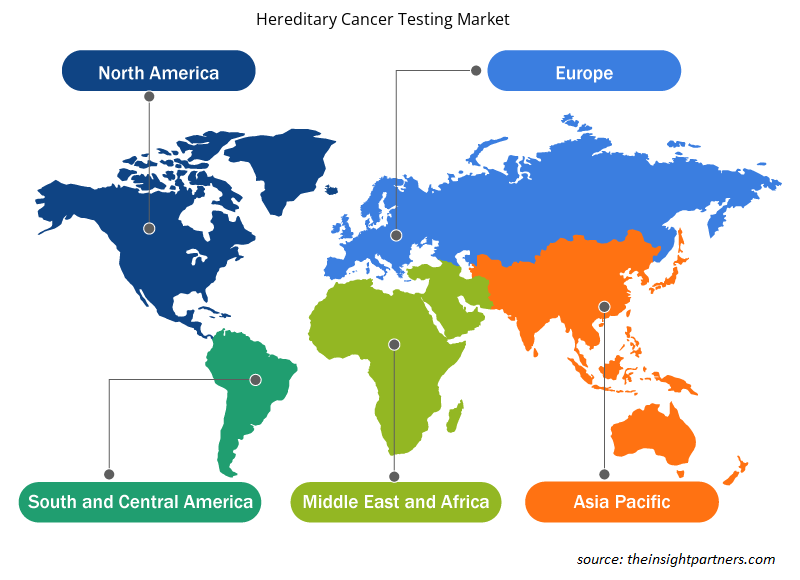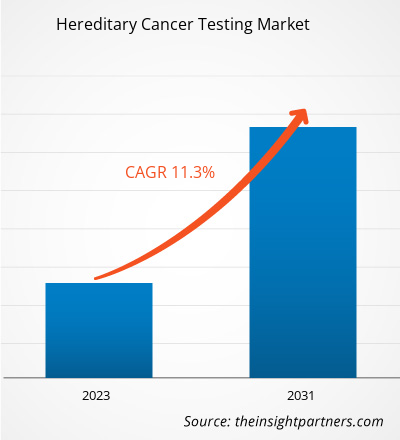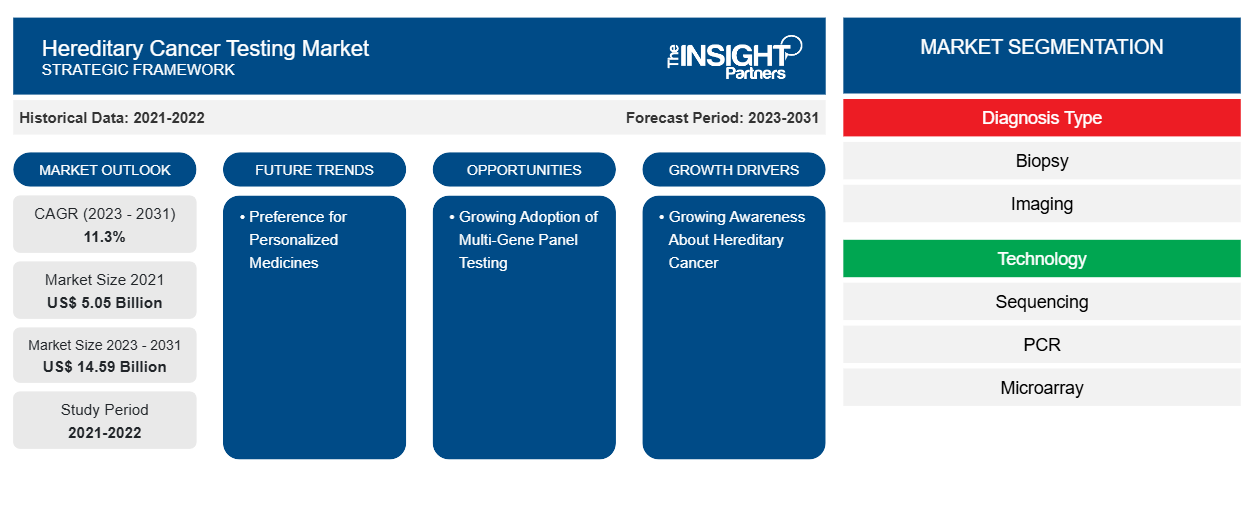Si stima che la dimensione del mercato dei test per il cancro ereditario sia stata di 5,05 miliardi di dollari USA nel 2021 e XX miliardi di dollari USA nel 2023 e si prevede che raggiungerà i 14,59 miliardi di dollari USA entro il 2031; si stima che registrerà un CAGR dell'11,3% nel 2023-2031. La crescente prevalenza del cancro ereditario e la crescente consapevolezza sul cancro ereditario sono fattori trainanti. La preferenza per i farmaci personalizzati rimarrà probabilmente la chiave per le tendenze del mercato dei test per il cancro ereditario.
Analisi di mercato dei test sul cancro ereditario
Il cancro è un disturbo genetico causato da variazioni definite nei geni che governano il funzionamento delle cellule, in particolare influenzandone la crescita e la replicazione. Le mutazioni genetiche ereditarie causano il 5-10% di tutti i tumori. I ricercatori hanno correlato le mutazioni in geni specifici con oltre 50 sindromi tumorali ereditarie che colpiscono gli individui che sviluppano determinati tumori. Inoltre, circa il 5-10% dei tumori al seno è correlato ai geni mutati ereditati dai genitori. Le variazioni nei geni BRCA1 e BRCA2 sono prevalenti. Le donne con una mutazione BRCA1 hanno circa il 72% di rischio nel corso della vita di sviluppare un tumore al seno, mentre quelle con la mutazione BRCA2 hanno circa il 69% di rischio dello stesso.
Panoramica del mercato dei test sul cancro ereditario
L'Asia Pacifica è il mercato in più rapida crescita per i test sui tumori ereditari. La regione ha un enorme potenziale per gli operatori del mercato dei test sui tumori ereditari grazie al sostegno governativo in paesi come la Corea del Sud per la sensibilizzazione sul cancro e altre iniziative. La domanda di sequenziamento genetico in Cina sta crescendo, principalmente a causa della crescente classe media del paese, della popolazione anziana e del sistema sanitario in crescita. Secondo i dati dell'OMS, il governo cinese ha implementato il piano "Healthy China 2030", che è utile per la sua popolazione.
Personalizza questo report in base alle tue esigenze
Riceverai la personalizzazione gratuita di qualsiasi report, comprese parti di questo report, o analisi a livello nazionale, pacchetto dati Excel, oltre a usufruire di grandi offerte e sconti per start-up e università
-
Scopri le principali tendenze di mercato in questo rapporto.Questo campione GRATUITO includerà analisi di dati che spaziano dalle tendenze di mercato alle stime e alle previsioni.
Driver e opportunità del mercato dei test sui tumori ereditari
Crescente consapevolezza sul cancro ereditario
La consapevolezza riguardo alle condizioni ereditarie del cancro sta crescendo grazie ai vari sforzi compiuti dal governo. Nell'ultimo decennio, le comunità mediche, sanitarie e scientifiche pubbliche hanno investito nella diffusione della consapevolezza riguardo alle condizioni ereditarie del cancro, con un'attenzione particolare al rischio di cancro ereditario, alla storia familiare e ai test genetici per la responsabilità del cancro ereditario. Inoltre, i produttori si stanno concentrando sull'adozione di strategie come lanci e approvazioni di prodotti, investimenti in R&S, finanziamenti governativi e partnership per fornire un facile accesso ai pazienti in tutto il mondo. Ad esempio, nell'aprile 2024, Ambry ha lanciato la collaborazione Inter-Organization Cancer Genetics Clinical Evidence Coalition (INTERACT) per stimolare i test sul cancro ereditario, con l'obiettivo di aumentare l'accesso ai test genetici specializzati.Ambry Launched the Inter-Organization Cancer Genetics Clinical Evidence Coalition (INTERACT) collaboration to spur hereditary cancer testing, aiming to increase access to specialized genetic testing.
Crescente adozione del test del pannello multi-gene: un’opportunità
Un pannello multi-gene elimina l'esecuzione di più analisi per diversi tipi di cancro o varianti. La variazione del numero di copie (CNV) è una fonte comune di variazione genetica ed è coinvolta in molti disturbi genetici. È anche una componente critica di una diagnosi di cancro ereditario.
Il governo del Regno Unito e Genomic England hanno dichiarato che tutte le analisi CNV saranno ora eseguite tramite NGS anziché tramite amplificazione della sonda dipendente dalla ligazione multiplex (MLPA). Grazie ai suoi vantaggi, tutti i processi di laboratorio saranno semplificati e consentiranno il rilevamento di tutte le varianti SNV, INDEL e CNV utilizzando un singolo flusso di lavoro e una pipeline di analisi.
L'adozione del test del pannello multigenico aumenterà in vari paesi del Nord America, Europa e Asia.
Analisi della segmentazione del rapporto di mercato sui test per il cancro ereditario
I segmenti chiave che hanno contribuito alla derivazione dell'analisi di mercato dei test per il cancro ereditario sono il tipo di diagnosi del prodotto, la tecnologia e l'utente finale.
- In base al tipo di diagnosi, il mercato dei test per il cancro ereditario è segmentato in biopsia e imaging. Il segmento della biopsia ha detenuto la quota di mercato maggiore nel 2023. Tuttavia, si prevede che il segmento dell'imaging registrerà il CAGR più elevato durante il periodo di previsione.
- In base alla tecnologia, il mercato dei test per il cancro ereditario è segmentato in sequenziamento, PCR e microarray. Il segmento del sequenziamento ha detenuto la quota di mercato più grande nel 2023 e si prevede che lo stesso segmento registrerà il CAGR più elevato durante il periodo di previsione.
- In base all'utente finale, il mercato dei test per il cancro ereditario è segmentato in centri diagnostici, ospedali e cliniche. Il segmento ospedaliero ha detenuto la quota di mercato più grande nel 2023. Inoltre, si stima che lo stesso segmento registrerà il CAGR più elevato nel mercato durante il periodo di previsione.
Analisi della quota di mercato dei test sul cancro ereditario per area geografica
L'ambito geografico del rapporto di mercato sui test per il cancro ereditario è suddiviso principalmente in cinque regioni: Nord America, Asia Pacifico, Europa, Medio Oriente e Africa e Sud America/Sud e Centro America.
Il mercato dei test per il cancro ereditario in Nord America è segmentato in Stati Uniti, Canada e Messico. Gli Stati Uniti detenevano la quota maggiore del mercato dei test per il cancro ereditario in Nord America nel 2023. La crescita prevista del mercato dei test per il cancro ereditario in Nord America è guidata dal crescente numero di pazienti affetti da cancro, dall'aumento dei finanziamenti governativi e dalla crescente incidenza di malattie genetiche tra la popolazione negli Stati Uniti e in Canada negli ultimi anni. Il governo ha anche preso iniziative per creare consapevolezza riguardo al cancro tra la popolazione. Ad esempio, l'American Society of Clinical Oncology (ASCO) offre un corso sulla consapevolezza del cancro per diffondere una conoscenza completa ed essenziale di questa condizione, inclusa la genetica del cancro ereditario.
Approfondimenti regionali sul mercato dei test sui tumori ereditari
Le tendenze regionali e i fattori che influenzano il mercato dei test per il cancro ereditario durante il periodo di previsione sono stati ampiamente spiegati dagli analisti di Insight Partners. Questa sezione discute anche i segmenti e la geografia del mercato dei test per il cancro ereditario in Nord America, Europa, Asia Pacifico, Medio Oriente e Africa e America meridionale e centrale.

- Ottieni i dati specifici regionali per il mercato dei test sul cancro ereditario
Ambito del rapporto di mercato sui test per il cancro ereditario
| Attributo del report | Dettagli |
|---|---|
| Dimensioni del mercato nel 2021 | 5,05 miliardi di dollari USA |
| Dimensioni del mercato entro il 2031 | 14,59 miliardi di dollari USA |
| CAGR globale (2023-2031) | 11,3% |
| Dati storici | 2021-2022 |
| Periodo di previsione | 2023-2031 |
| Segmenti coperti |
Per tipo di diagnosi
|
| Regioni e Paesi coperti |
America del Nord
|
| Leader di mercato e profili aziendali chiave |
|
Densità degli operatori del mercato dei test sul cancro ereditario: comprendere il suo impatto sulle dinamiche aziendali
Il mercato dei test per il cancro ereditario sta crescendo rapidamente, spinto dalla crescente domanda degli utenti finali dovuta a fattori quali l'evoluzione delle preferenze dei consumatori, i progressi tecnologici e una maggiore consapevolezza dei benefici del prodotto. Con l'aumento della domanda, le aziende stanno ampliando le loro offerte, innovando per soddisfare le esigenze dei consumatori e capitalizzando sulle tendenze emergenti, il che alimenta ulteriormente la crescita del mercato.
La densità degli operatori di mercato si riferisce alla distribuzione di aziende o società che operano in un particolare mercato o settore. Indica quanti concorrenti (operatori di mercato) sono presenti in un dato spazio di mercato in relazione alle sue dimensioni o al valore di mercato totale.
Le principali aziende che operano nel mercato dei test sul cancro ereditario sono:
- Azienda
- Koninklijke Philips NV
- Diagnostica di ricerca incorporata
- Azienda: Myriad Genetics, Inc.
- Genetica del cancro Inc.
- Invitae Corporation
Disclaimer : le aziende elencate sopra non sono classificate secondo un ordine particolare.

- Ottieni una panoramica dei principali attori del mercato dei test sul cancro ereditario
Notizie di mercato e sviluppi recenti sui test per il cancro ereditario
Il mercato dei test per il cancro ereditario viene valutato raccogliendo dati qualitativi e quantitativi da ricerche primarie e secondarie, che includono importanti pubblicazioni aziendali, dati di associazioni e database. Di seguito è riportato un elenco degli sviluppi nel mercato dei test per il cancro ereditario:
- Exact Sciences Corp. ha annunciato il lancio del test per il cancro ereditario Riskguard negli Stati Uniti. Questo test fornisce un rapporto personalizzato del paziente che include rischi specifici per gene e familiari utilizzando un semplice campione di sangue o saliva per 10 tumori comuni, tra cui colorettale , endometriale, gastrico, pancreatico, mammario, prostatico, cutaneo, ovarico, renale ed endocrino. (Exact Sciences Corp /Comunicato stampa, febbraio 2024)
- Devyser ha annunciato il lancio di due nuovi prodotti, Devyser LynchFAP e Devyser BRCA PALB2. Questi kit offrono un'analisi efficiente, mirata e affidabile dei geni associati a un rischio di cancro aumentato. Devyser LynchFAP fornisce una soluzione completa per analizzare PMS2 e altri 9 geni associati a sindromi ereditarie del cancro colorettale (Fonte: Devyser, comunicato stampa, giugno 2023)
Copertura e risultati del rapporto di mercato sui test per il cancro ereditario
Il rapporto "Dimensioni e previsioni del mercato dei test sul cancro ereditario (2021-2031)" fornisce un'analisi dettagliata del mercato che copre le seguenti aree:
- Dimensioni e previsioni del mercato a livello globale, regionale e nazionale per tutti i segmenti di mercato chiave coperti dall'ambito
- Dinamiche di mercato come fattori trainanti, vincoli e opportunità chiave
- Principali tendenze future
- Analisi dettagliata delle cinque forze PEST/Porter e SWOT
- Analisi di mercato globale e regionale che copre le principali tendenze di mercato, i principali attori, le normative e gli sviluppi recenti del mercato
- Analisi del panorama industriale e della concorrenza che copre la concentrazione del mercato, l'analisi della mappa di calore, i principali attori e gli sviluppi recenti
- Profili aziendali dettagliati
- Analisi storica (2 anni), anno base, previsione (7 anni) con CAGR
- Analisi PEST e SWOT
- Valore/volume delle dimensioni del mercato - Globale, Regionale, Nazionale
- Industria e panorama competitivo
- Set di dati Excel
Report recenti
Rapporti correlati
Testimonianze
Motivo dell'acquisto
- Processo decisionale informato
- Comprensione delle dinamiche di mercato
- Analisi competitiva
- Analisi dei clienti
- Previsioni di mercato
- Mitigazione del rischio
- Pianificazione strategica
- Giustificazione degli investimenti
- Identificazione dei mercati emergenti
- Miglioramento delle strategie di marketing
- Aumento dell'efficienza operativa
- Allineamento alle tendenze normative























 Ottieni un campione gratuito per - Mercato dei test per il cancro ereditario
Ottieni un campione gratuito per - Mercato dei test per il cancro ereditario